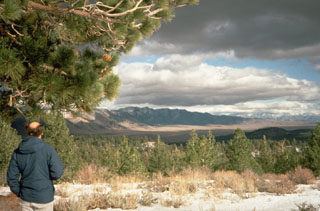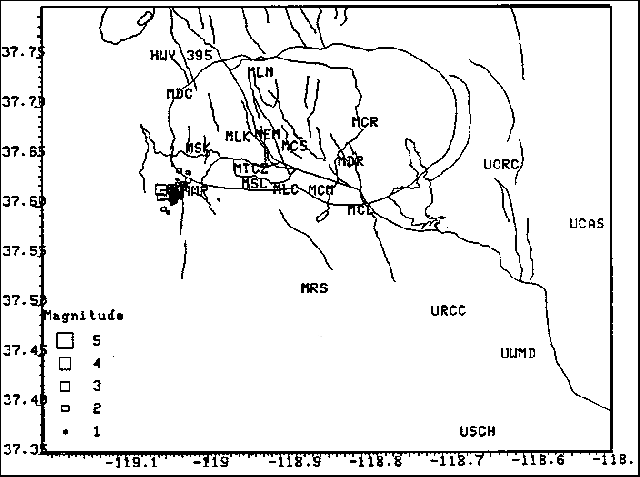Report on Long Valley (United States) — June 1989
Scientific Event Alert Network Bulletin, vol. 14, no. 6 (June 1989)
Managing Editor: Lindsay McClelland.
Long Valley (United States) Earthquake swarm near caldera rim
Please cite this report as:
Global Volcanism Program, 1989. Report on Long Valley (United States) (McClelland, L., ed.). Scientific Event Alert Network Bulletin, 14:6. Smithsonian Institution. https://doi.org/10.5479/si.GVP.SEAN198906-323822
Long Valley
United States
37.7°N, 118.87°W; summit elev. 3390 m
All times are local (unless otherwise noted)
An earthquake swarm began 4 May under the SSW flank of Mammoth Mountain, just outside the SW caldera rim (figure 7). The number of events increased through early June, with 44 recorded on the 11th. Seismicity was continuing as of 10 July, and totaled 712 recorded events (magnitude greater than or equal to 0.3) (figure 8). Most were small (M <1); the largest, M 3.1, occurred on 21 June at 0058. As the swarm continued, most of the events remained centered beneath the SW flank of Mammoth Mountain, on strike with the Inyo chain, at depths ranging from 2 to 9 km. Focal depths during previous swarms have generally been around 6 km. Most of the shallower earthquakes showed less high-frequency energy in their spectra, probably because of attenuation effects, but had clear S-waves and were therefore not considered low-frequency events. However, seven low-frequency events were recorded on 11 June. Several mixed-frequency events had high-frequency P and S-waves superimposed on 1-2-Hz waves, suggesting possible resonance of a fluid-filled cavity. Possible spasmodic tremor was recorded for 2-3 minutes on 2 and 26 June, and 6 July.
 |
Figure 8. Number of local earthquakes per day recorded by the California Division of Mines and Geology NEWT system, 5 May-30 September. Courtesy of Stephen McNutt. |
The Devils Postpile dilatometer, near the W foot of Mammoth Mountain, recorded 0.05 microstrain of deformation during the swarm's most active day, 11 June. No significant changes to existing trends were reported from other instruments a few kilometers away.
The May-July swarm is the largest near Mammoth Mountain in 3.5 years; a small swarm occurred there in January 1987. During the past 4 years, virtually all of the other seismic swarms in the Mammoth Lakes area have lasted only a few days. The largest recent swarm, 393 recorded events in the caldera's E moat, began 22 November 1988 and ended after 3 days.
Geological Summary. The large 17 x 32 km Long Valley caldera east of the central Sierra Nevada Range formed as a result of the voluminous Bishop Tuff eruption about 760,000 years ago. Resurgent doming in the central part of the caldera occurred shortly afterwards, followed by rhyolitic eruptions from the caldera moat and the eruption of rhyodacite from outer ring fracture vents, ending about 50,000 years ago. During early resurgent doming the caldera was filled with a large lake that left strandlines on the caldera walls and the resurgent dome island; the lake eventually drained through the Owens River Gorge. The caldera remains thermally active, with many hot springs and fumaroles, and has had significant deformation, seismicity, and other unrest in recent years. The late-Pleistocene to Holocene Inyo Craters cut the NW topographic rim of the caldera, and along with Mammoth Mountain on the SW topographic rim, are west of the structural caldera and are chemically and tectonically distinct from the Long Valley magmatic system.
Information Contacts: S. McNutt, California Division of Mines and Geology, Sacramento.


